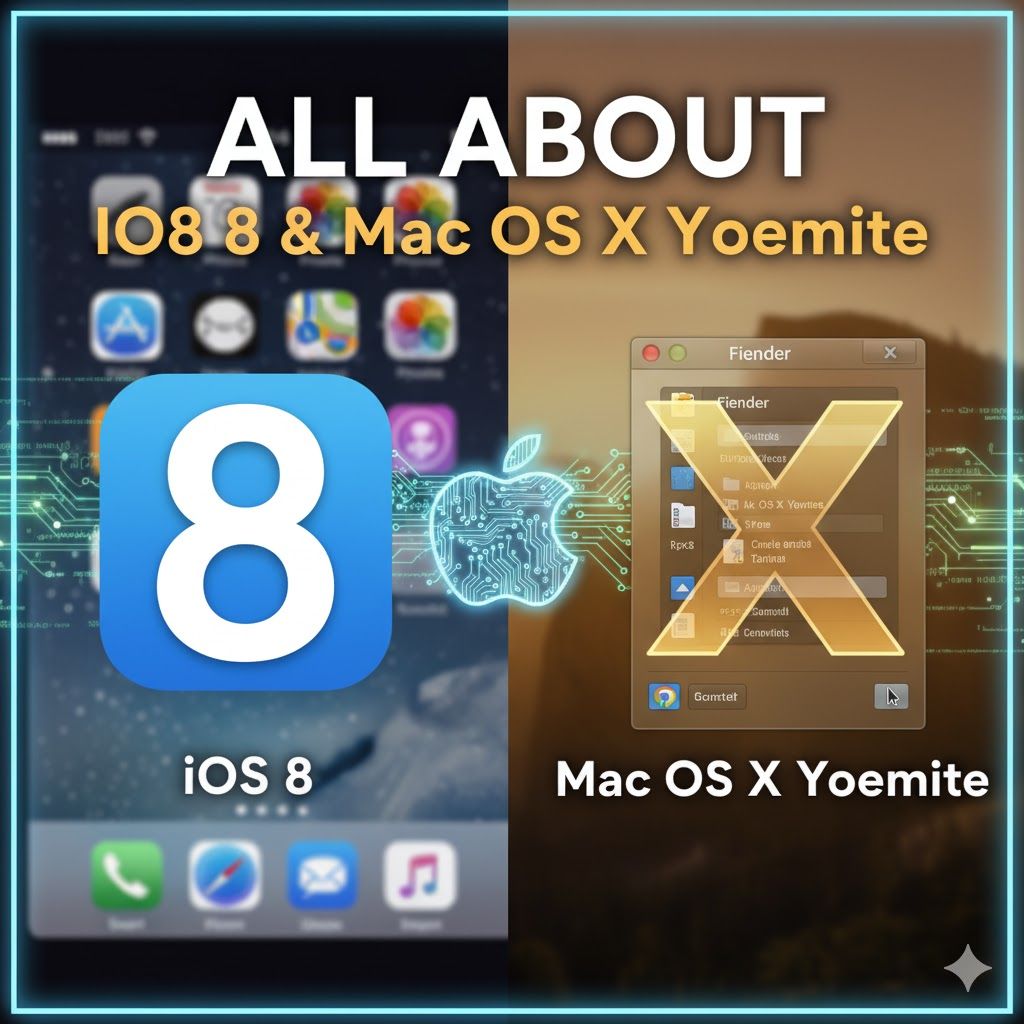All about iOS 8 & Mac OS X Yosemite
Apple is renowned for its continuous enhancements to both its mobile (iOS) and desktop (Mac OS X) operating systems. This commitment was once again evident at the recent WorldWide

Admin

All about iOS 8 & Mac OS X Yosemite
Apple is renowned for its continuous enhancements to both its mobile (iOS) and desktop (Mac OS X) operating systems. This commitment was once again evident at the recent WorldWide Developers Conference, where the company unveiled Mac OS X ‘Yosemite’, the successor to OS X Mavericks, and introduced iOS 8 for its mobile devices. Let's delve into some of the significant new features and alterations present in OS X Yosemite and iOS 8.
Credit: syncios.com
Mac OS X Yosemite
Last year, Apple departed from its traditional "big cats" naming scheme for OS X with the launch of Mavericks. Now, versions are named after iconic Californian landmarks, with Yosemite being the latest choice. OS X Yosemite represents the most extensive visual overhaul Mac OS X has seen since its inception. It embraces a design language mirroring that of iOS 7 (and iOS 8), giving it a distinctive iOS-like appearance on the Mac. Despite these aesthetic changes, the fundamental performance and user experience remain consistent, if not improved.
Redesign
The most striking aspect of Yosemite is its complete redesign, drawing parallels to the significant UI transformation iOS 7 brought compared to iOS 6. The Dock and all application icons now feature a flat design. Windows are no longer metallic silver; instead, they are white and semi-translucent, allowing users to glimpse content beneath them. The system-wide fonts have been updated, and numerous buttons have also been restyled. Toolbars have been "streamlined," meaning they are more space-efficient, enabling users to view more information within a window, whether in fullscreen or alongside other desktop applications.
Spotlight
Spotlight has been a core component of Mac OS X from its earliest versions, traditionally functioning as a simple search tool for applications, files, and emails on your Mac. However, in Yosemite, Spotlight has been significantly enhanced, redesigned, and made much more intelligent. While it continues to search your Mac locally as you type, it now also extends its search capabilities to the web. If a relevant Wikipedia entry is found, it provides a preview directly within Spotlight. Furthermore, searching for music or movies will suggest purchasable content from the iTunes Store. The same applies to apps. Quick currency and unit conversions are also now possible. This new Spotlight is far more capable than its predecessor, promising to boost productivity by quickly delivering necessary information.
Notification Center
First introduced in Mac OS X Mountain Lion, the Notification Center has seen minimal changes until now. In Yosemite, it adopts the visual style of its iOS counterpart. Additionally, a new 'Today' tab has been added, displaying calendar entries, weather, reminders, and other widgets. Crucially, it supports widgets from third-party applications, offering developers new opportunities to integrate their apps.
The default Mail application in OS X is already feature-rich, and Apple has expanded its capabilities further. A new iCloud integration called ‘MailDrop’ allows users to send exceptionally large files (up to 5GB) via email without standard attachment size limitations. This works by uploading the file to the user's iCloud account and sending a link within the email. Another innovative feature, ‘Markup,’ enables users to edit images directly within the Mail app. Adding text, arrows, annotations, or even magnifying specific parts of an image can all be done without leaving the Mail interface.
Safari
Safari in Yosemite presents a cleaner, more refined look. Its toolbar is decluttered, and the address bar, now called ‘Smart Search,’ displays favorite sites when clicked, eliminating the need for a separate favorites bar. Managing multiple tabs is also easier with a new tab view that organizes all open tabs by their respective websites. The Smart Search bar functions much like the enhanced Spotlight, offering instant results from Wikipedia and other online sources as you type. Beyond these visible changes, underlying improvements in JavaScript performance and energy efficiency contribute to better battery life.
Messages & Phone calls
Previously, the Messages app was limited to sending messages between Macs and iOS devices. Now, users can send SMS messages directly from their Mac’s Messages app, provided their iPhone is nearby. All sent and received SMS conversations are synced and visible on the Mac. Beyond SMS, users can also make and receive phone calls directly from their Mac, without needing to pick up their iPhone. This seamless integration allows for calling numbers found in the address book or even on a webpage with a simple click.
iCloud Drive
iCloud is now deeply integrated into the Mac, ensuring that all documents, spreadsheets, and presentations stored in a user's iCloud account are accessible. All these documents remain in sync across other devices configured with the same iCloud account.
Photos
While the Photos app is a familiar part of iOS, Apple has announced its arrival on OS X next year. It will largely mirror its iOS counterpart, organizing photos by time into 'collections' and 'moments.' Users will be able to search through, edit, and manage their photos, with all changes instantly reflecting across all their connected devices.
Other Notable Improvements
Additional improvements in OS X Yosemite include the ability to ‘AirDrop’ files wirelessly to and from iOS devices. A smaller yet much-appreciated feature is the new ‘dark mode,’ which transforms the typically white and bright menus into a darker aesthetic. Mac OS X Yosemite is set to be released as a free download from the Mac App Store this fall, with no specific date announced yet. For the first time, Apple has also made a public beta version available, alongside the developer beta, breaking from its past practice of only offering developer betas. Interested users can sign up for the beta program via the provided link.
Credit: apple.com
iOS 8
Following the significant visual and functional changes introduced with iOS 7 last year, iOS 8 builds upon that foundation, further aligning itself with the Mac experience. This year, Apple's primary objective is to create the most fluid and seamless interaction between Macs and iOS devices, a goal clearly demonstrated by the enhanced communication between OS X Yosemite and iOS 8. The synergy between the two platforms is stronger than ever, and here’s what iOS 8 brings to the table.
Continuity
OS X Yosemite not only adopts design cues from iOS but also boasts exceptional interoperability, a suite of features Apple terms ‘Continuity’. This collection is designed to make iOS and OS X work collaboratively. A key feature within Continuity is ‘Handoff.’ For instance, if you start drafting an email on your iPad and then move to your Mac, you can seamlessly continue writing the email on the Mac, picking up exactly where you left off. This functionality works bidirectionally and extends to various applications like Safari, Maps, and Reminders, provided both devices are linked to the same iCloud account. As previously mentioned, the ability to send and receive SMS and phone calls from a Mac when an iPhone is nearby is also a part of Continuity. Furthermore, an intelligent feature allows an iPhone to automatically act as a Wi-Fi hotspot for a Mac, without requiring any manual setup.
Messages
The default Messages app in iOS receives several new features, some of which are already common in other platforms but new to iOS. These include the ability to send voice messages, self-destructing photos (akin to Snapchat) and videos, and share your current location. Users can also now easily leave group conversations.
Interactive Notifications
Previously, iOS notifications could be disruptive, often requiring users to navigate to the corresponding app to respond. iOS 8 introduces interactive notifications. For example, a text message notification can be pulled down, allowing for a quick reply directly from the notification itself, without having to leave the app currently in use. This functionality extends to various notifications and apps, with support planned for third-party applications. Lock screen notifications will also become interactive, a significant upgrade from the passive notifications in iOS 7.
QuickType and Third Party Keyboards
iOS 8 includes ‘QuickType,’ an intelligent keyboard that learns a user’s typing habits and response patterns. It provides predictive suggestions tailored to specific contexts, helping users respond to emails or type text quickly and efficiently. Even more exciting is the fact that iOS 8 now opens the door for developers to create and integrate third-party keyboards. This means iOS device users can anticipate popular options like Swype keyboards or customizable, skinnable keyboards similar to those found on Android.
Widgets
Widgets finally make their debut on iOS devices with iOS 8, though not in the expansive Android-like manner. Similar to OS X Yosemite, widgets will reside exclusively within the Notification Center. Both iOS’s native stock apps and third-party applications will offer widgets. This much-requested feature is expected to be a valuable addition to both the iOS and OS X platforms.
Health
iOS 8 introduces an entirely new Health app designed to centralize health-related data. It can interact with various other health-tracking applications (such as those accompanying gadgets like FitBit or Nike+) to consolidate all health information into one accessible location. This aims to bring together data that might otherwise be scattered across multiple apps. Users can also choose to share this data with their preferred healthcare providers. It is widely speculated that this app could serve as a companion for Apple’s rumored smartwatch, which is believed to be in development.
Other Notable Features
Other significant features in iOS 8 include a new ‘favorite contacts’ menu accessible from the multitasking screen (by double-tapping the home button), allowing quick calls, SMS, or FaceTime calls with frequently contacted individuals. Safari has also been enhanced with reading lists, favorites, and the same tab view seen in the OS X Yosemite version of Safari. Similarly, Spotlight search in iOS has been revamped, mirroring the improvements made in OS X Yosemite. iOS 8 is slated for public release this fall, with a developer beta already available. Apple has clearly dedicated substantial effort to integrate iOS and OS X more closely, and these efforts appear to be quite successful. We await the fall release to witness both OS updates in action and observe their impact on Apple's user base.